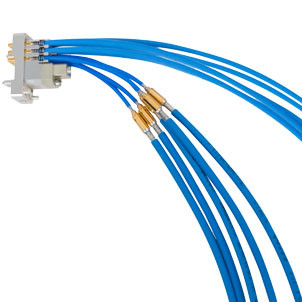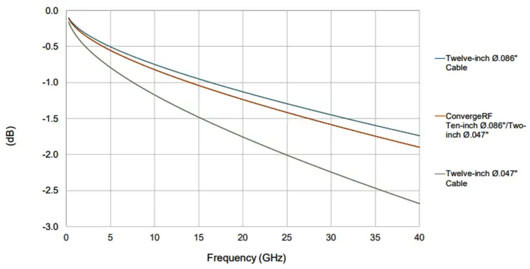25-04-2025 | SV Microwave | Industrial
RF signal paths continue to increase in frequency and density. However, when running long cable assemblies in tight packaging, we are still faced with choosing between small-diameter, flexible cables with high insertion loss or large-diameter, less flexible cable types unsuitable for tight routing situations. One common solution is to use two discreet cable assemblies.
However, this introduces more interfaces, handling, and performance degradation into the overall design.
What if you didn’t have to choose?

Render of ConvergeRF Cable Splice
SV Microwave’s ConvergeRF capability allows the best of both world's by creating a short run of a Ø.047 cable and transitioning it to a longer, less-lossy Ø.085 or larger-diameter cable without any additional interfaces.
This gives flexibility where needed, while minimising overall insertion loss.
Features and Benefits
Applications
ConvergeRF is helpful in various applications:
However, it is particularly useful in VITA 67.3 and HD VITA 67.3 Plug-In Modules, where cables need tight routing inside the chassis. The company is now officially licensed to offer NanoRF modules and contacts that adhere to the latest standards:
This addition to its SMPS and SMPM VITA offerings highlights its commitment to staying at the forefront of VITA Technologies and allowing it to offer a full VITA 67.3 solution.
The company can now offer NanoRF contacts and modules for ConvergeRF to protect signal integrity in tight routing situations in the backplane and long routing runs.

A NanoRF Module Populated with ConvergeRF Cables
Another common use of ConvergeRF is for Mini-D RF cable assemblies. These connectors are high-density, but their small form factor requires a Ø.047" cable, so insertion loss can become an issue.

Mini-D Cable Assembly Populated with ConvergeRF Cables
However, with ConvergeRF, we can transition into a Ø.085" or larger-diameter cable type and secure a lower insertion loss without adding any additional interfaces or handling.
While these are both great examples of ConvergeRF in use, this capability is helpful for any situation where routing is tight and low insertion loss is critical.
The Proof
The plot below shows insertion loss in dB from 0-40GHz for three different configurations, using standard and cable sizes vs ConvergeRF.
As shown below, ConvergeRF lowers the total insertion loss by nearly 40% compared to a Ø.047” cable.

Insertion loss difference between ConvergeRF and standard cables
Want to Learn More or Make Your Own Configuration?
Interested in learning more about ConvergeRF or want to see how the company can help you? Visit the Buy Now button to browse the company's website.
